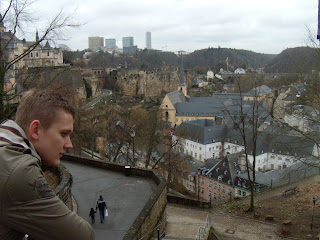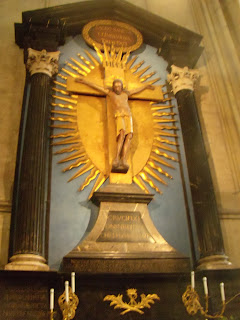Antwerp is one of the more cosmopolitan cities in Belgium. I think a lot of that has to do with the fact that it has one of the best ports in Europe which makes it the second busiest port in Europe behind Rotterdam. Of all the goods that pass through Antwerp, the most famous are probably the diamonds which have historically and for the most part continue to be dominated by Hasidic Jews. In other words, if you want to see the diamond trade, it would be best not to go to Antwerp on a Saturday considering that is the Jewish Sabbath. (I went on a Saturday and the diamond centers were completely deserted).
The train station was an architectural masterpiece in and of itself. Nothing like stepping off the train into a neo-baroque style masterpiece built in 1904...gotta love Europe!
There are a number of stories as to how the city of Antwerp got its name, but my favorite involves the statue in the middle of the city. According to folklore, there was a a giant who would charge a toll in order to cross the river. If you refused to pay the toll, he would chop off your hand. Eventually a young man gave the giant what he had coming and chopped off his hand which is what the statute, and I am lamely trying to, represent. So the name Antwerpen comes from the Dutch "hand werpen" meaning "hand to throw".


This is "Butcher's Hall" and is one of the oldest surviving buildings in Antwerp. It was completed in 1504 and the red brick and white sandstone are meant to mimic the look of meat with its layers of fat.
The Cathedral of Our Lady shown above and below is a huge landmark and amazing attraction in Antwerp. The church is the tallest cathedral in the Low Countries (Belgium, Netherlands, Luxembourg, and parts of Franch and Germany). My favorite part of the cathedral and of Antwerp in general, were the amazing Tryptychs by the Flemish artist Rubens. If you look at the pictures of the paintings below (sorry they are a bit blurry) you'll notice that he often uses diagonals to invoke the sense of movement in his works. This adds depth, motion, space, and the sense of time and they were amazing.
The cathedral took over 200 years to build and the professor giving us a tour commented that at the time, the average lifespan was only around 40 years. In other words, families and generations of a families spent their entire life's working on a building that they never saw completed to its fruition (in fact the church remains "incomplete" as only of the planned two spires has been completed). How often in our lives do we work to an end that we don't ever see completed...does that mean we should work towards an end if we won't see it. The church was a good reminder to me that sometimes its not the end or the reward that is the most important, but its the process of learning and growing along the way which provides the greatest lessons.



























































